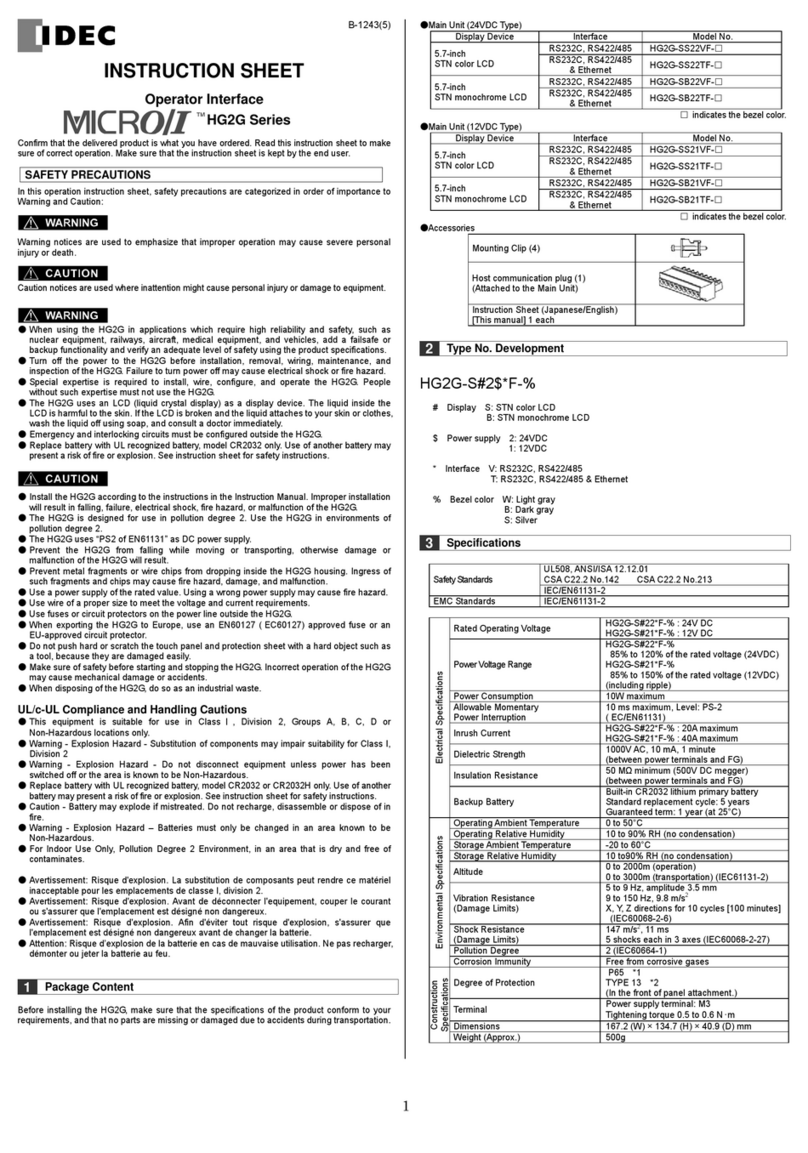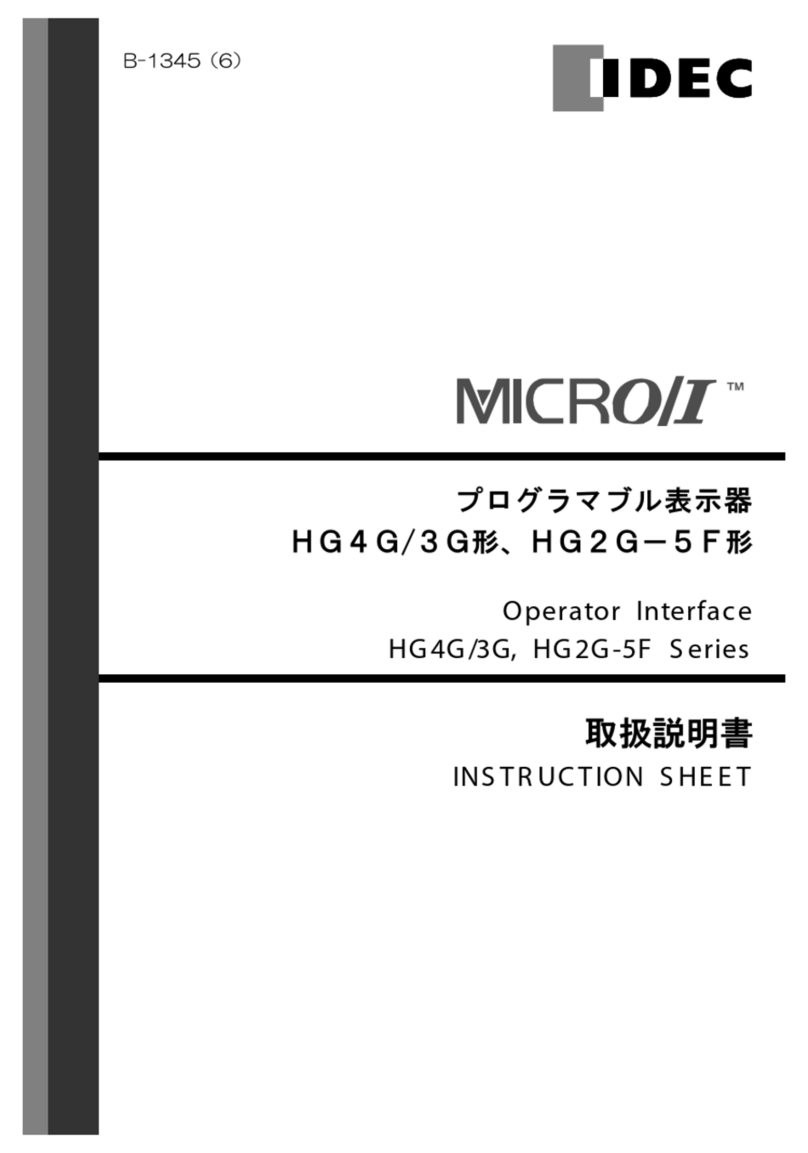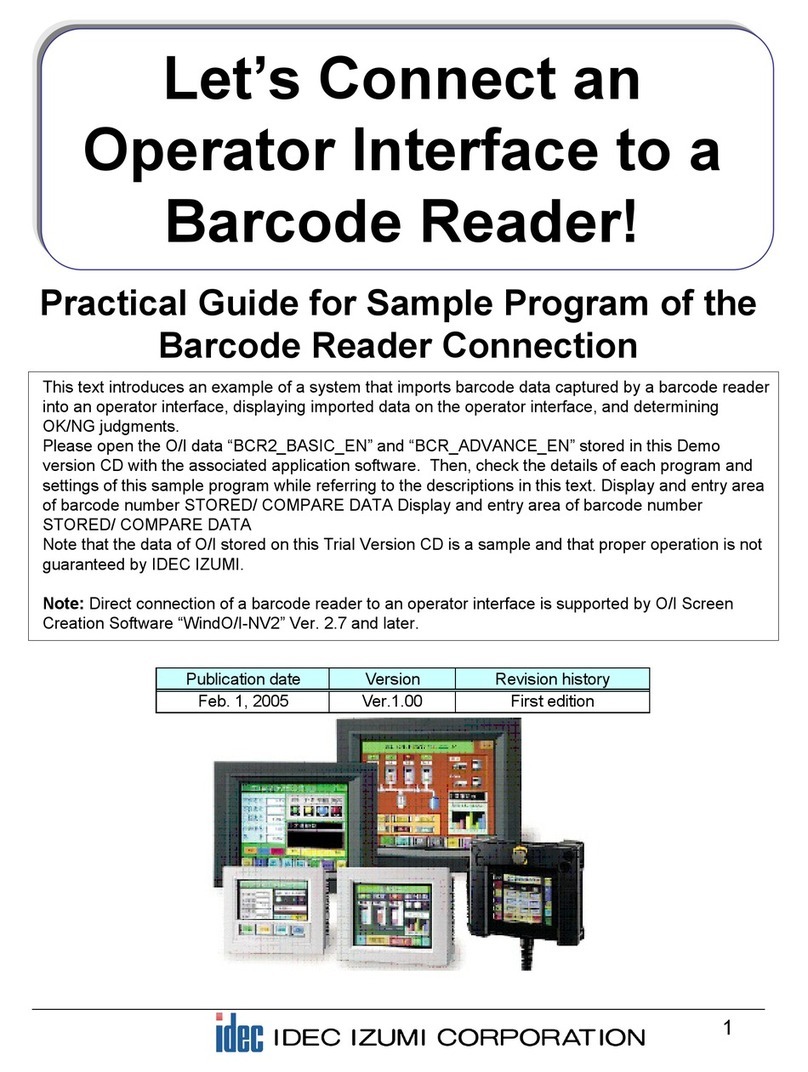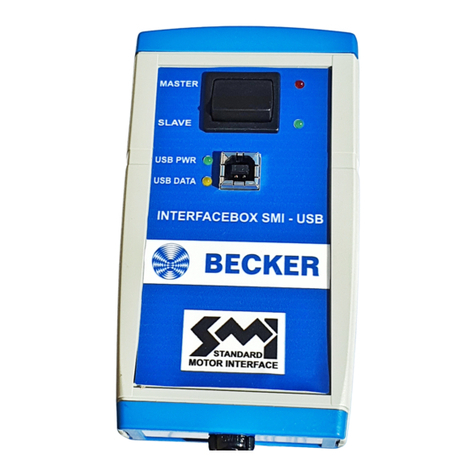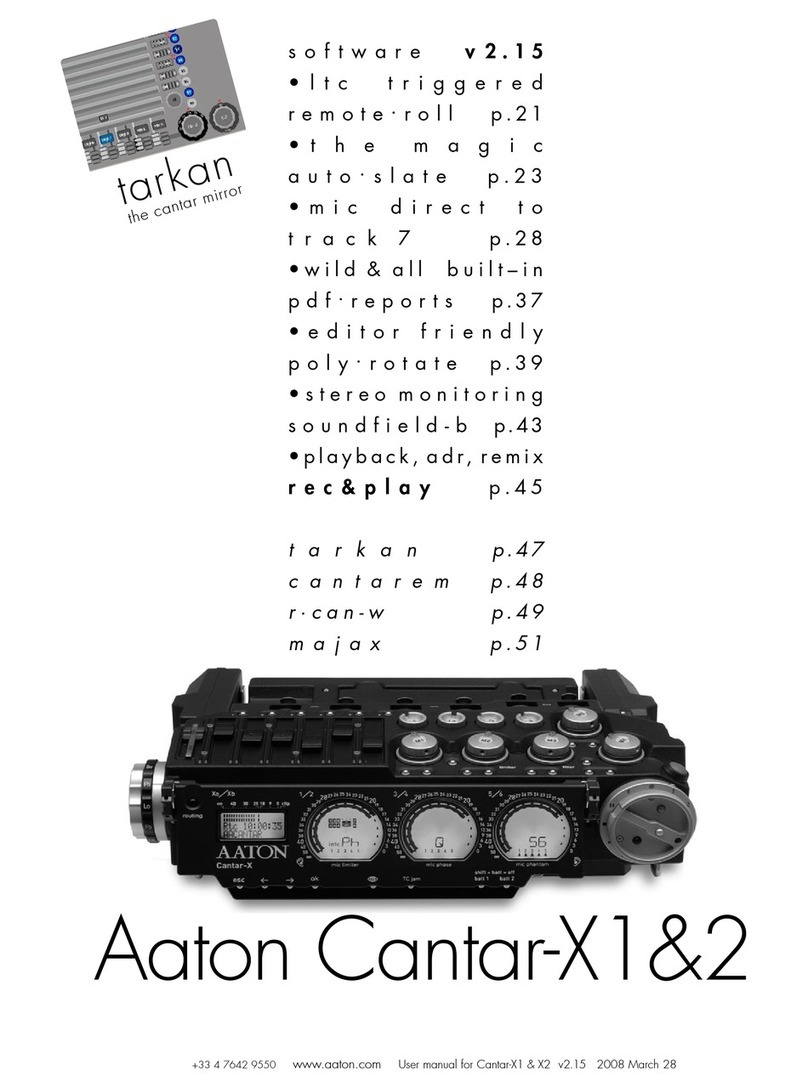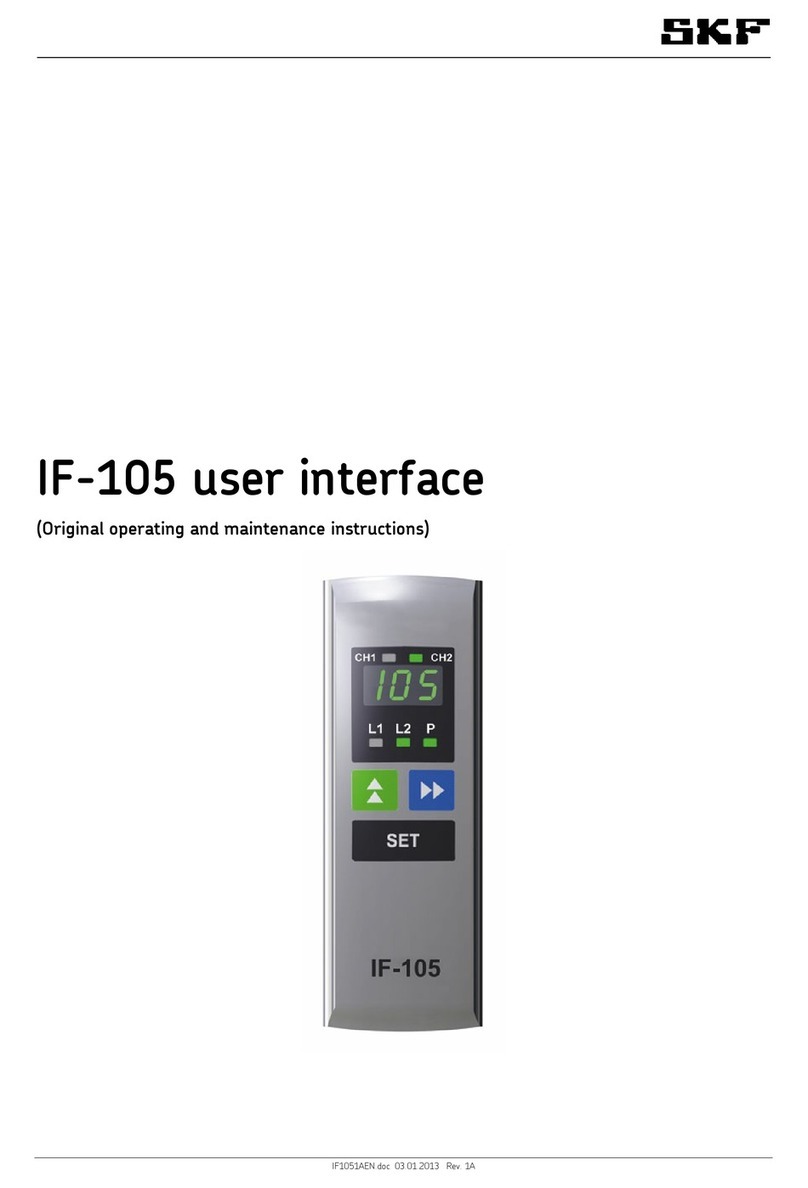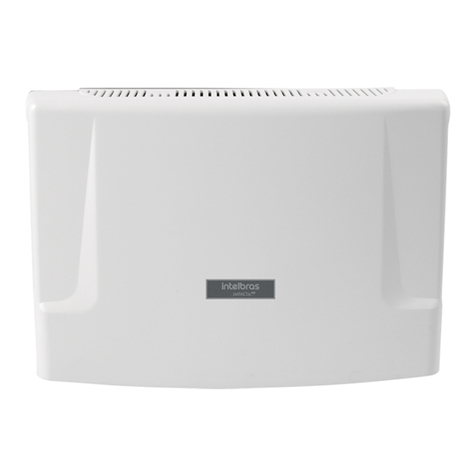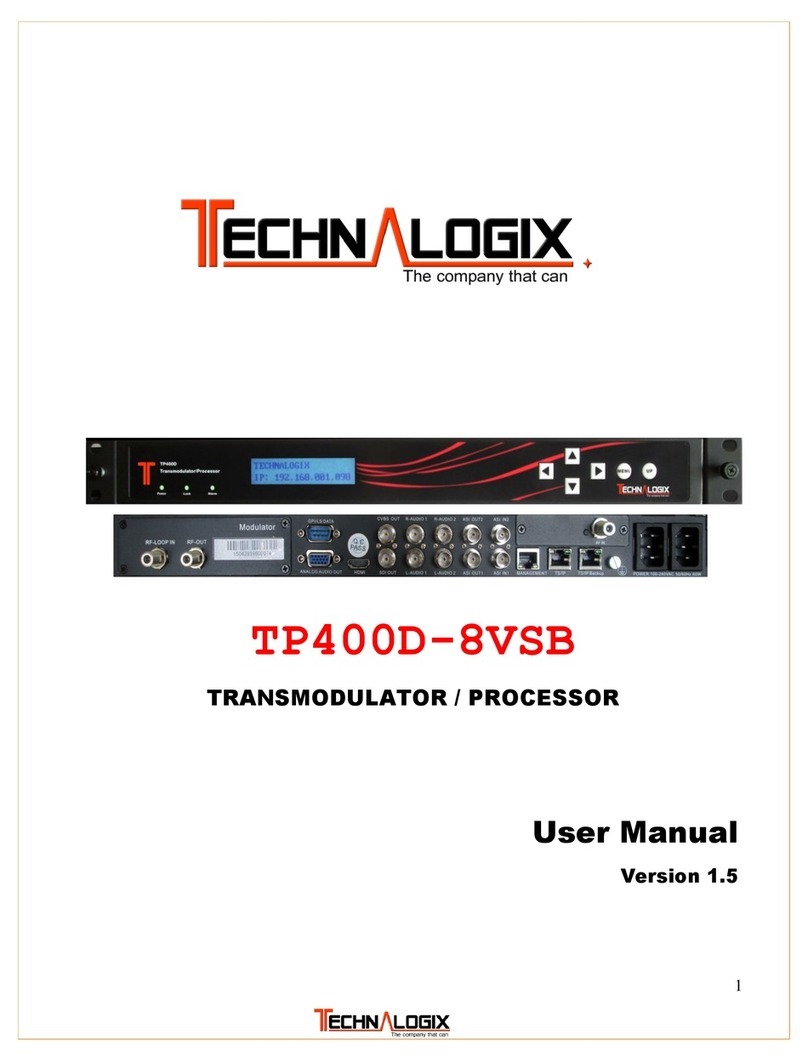IDEC LonWorks FC3A-SX5LS1 User manual

OPENNET CONTROLLER LONWORKS INTERFACE MODULE USER’SMANUAL i
LONWORKS INTERFACE MODULE
TABLE OF CONTENTS
OpenNet Interface Modules . . . . . . . . . . . . . . . . . . . . . . . . . . . . . . . . . . . . . . . . . . . 1
LONWORKS Interface Module Features . . . . . . . . . . . . . . . . . . . . . . . . . . . . . . . . . . . . 1
About LON . . . . . . . . . . . . . . . . . . . . . . . . . . . . . . . . . . . . . . . . . . . . . . . . . . . . . . . 1
LONWORKS Network Components . . . . . . . . . . . . . . . . . . . . . . . . . . . . . . . . . . . . . . . . 2
LONWORKS Network System Setup . . . . . . . . . . . . . . . . . . . . . . . . . . . . . . . . . . . . . . . 3
LONWORKS Interface Module Parts Description . . . . . . . . . . . . . . . . . . . . . . . . . . . . . . 4
LONWORKS Interface Module Specifications . . . . . . . . . . . . . . . . . . . . . . . . . . . . . . . . 5
Wiring LONWORKS Interface Module . . . . . . . . . . . . . . . . . . . . . . . . . . . . . . . . . . . . . . 6
Terminator . . . . . . . . . . . . . . . . . . . . . . . . . . . . . . . . . . . . . . . . . . . . . . . . . . . . . . . 7
Link Registers for LONWORKS Network Communication . . . . . . . . . . . . . . . . . . . . . . . . 8
Transmission Time . . . . . . . . . . . . . . . . . . . . . . . . . . . . . . . . . . . . . . . . . . . . . . . . . 9
Function Area Setting for LONWORKS Node . . . . . . . . . . . . . . . . . . . . . . . . . . . . . . . . 10
Programming Transmit/Receive Data Using WindLDR . . . . . . . . . . . . . . . . . . . . . . . . 11
Starting Operation . . . . . . . . . . . . . . . . . . . . . . . . . . . . . . . . . . . . . . . . . . . . . . . . . 12
Network Management . . . . . . . . . . . . . . . . . . . . . . . . . . . . . . . . . . . . . . . . . . . . . . 12
Precautions for Modifying Application Program . . . . . . . . . . . . . . . . . . . . . . . . . . . . . 13
LONWORKS Interface Module Internal Structure . . . . . . . . . . . . . . . . . . . . . . . . . . . . . 14
Data Exchange between LONWORKS Interface Module and CPU Module . . . . . . . . . . . 16
Application Program Examples . . . . . . . . . . . . . . . . . . . . . . . . . . . . . . . . . . . . . . . . 18
Initialization . . . . . . . . . . . . . . . . . . . . . . . . . . . . . . . . . . . . . . . . . . . . . . . . . . . 18
Writing Receive Data to Data Registers in the LONWORKS Interface Module . . . . . . 21
Reading Transmit Data from Data Registers in the LONWORKS Interface Module . . . 22
Defined Network Variables . . . . . . . . . . . . . . . . . . . . . . . . . . . . . . . . . . . . . . . . . . . 23
LONWORKS Network Troubleshooting . . . . . . . . . . . . . . . . . . . . . . . . . . . . . . . . . . . . 25
Troubleshooting Diagram 1 . . . . . . . . . . . . . . . . . . . . . . . . . . . . . . . . . . . . . . . . 25
Troubleshooting Diagram 2 . . . . . . . . . . . . . . . . . . . . . . . . . . . . . . . . . . . . . . . . 26
Troubleshooting Diagram 3 . . . . . . . . . . . . . . . . . . . . . . . . . . . . . . . . . . . . . . . . 27
Troubleshooting Diagram 4 . . . . . . . . . . . . . . . . . . . . . . . . . . . . . . . . . . . . . . . . 28
Troubleshooting Diagram 5 . . . . . . . . . . . . . . . . . . . . . . . . . . . . . . . . . . . . . . . . 28
Troubleshooting Diagram 6 . . . . . . . . . . . . . . . . . . . . . . . . . . . . . . . . . . . . . . . . 28
Index . . . . . . . . . . . . . . . . . . . . . . . . . . . . . . . . . . . . . . . . . . . . . . . . . . . . . . . . . . 29

OPENNET CONTROLLER LONWORKS INTERFACE MODULE USER’SMANUAL 1
LONWORKS INTERFACE MODULE
Introduction
This manual describes LONWORKS interface module FC3A-SX5LS1 used with the OpenNet Controller™ to interface with
the LONWORKS network, and provides details on the LONWORKS system setup and the LONWORKS interface module spec-
ifications.
For general information about safety precautions, installation, wiring, and dimensions, see the OpenNet Controller user’s
manual EM333.
OpenNet Interface Modules
The OpenNet Controller can be linked to three major open networks; INTERBUS, DeviceNet™, and LONWORKS®. For
communication through these networks, OpenNet interface modules are available. Mounting the LONWORKS interface
module beside the OpenNet Controller CPU module makes up a node on a LONWORKS network. The node can communi-
cate I/O data with other nodes in a distributed network.
LONWORKS Interface Module Features
The LONWORKS interface module conforms to the specifications of LONWORKS that is recognized worldwide as a de facto
industry standard open network, so the OpenNet Controller can be linked to the LONWORKS networks consisting of LON-
WORKS compliant products manufactured by many different vendors, such as I/O terminals, sensors, drives, operator inter-
faces, and barcode readers. The flexible, configurable, and interoperable features of the LONWORKS network make it
possible to build, expand, or modify production lines with reduced cost.
The transmit/receive data quantity can be selected from 0 through 8 bytes (64 bits) in 1-byte increments. One LONWORKS
interface module enables the OpenNet Controller CPU module to transmit 64 bits and receive 64 bits at the maximum to
and from the LONWORKS network.
The network can be configured either in bus or free topology. The total transmission distance can be 1,400m in bus topol-
ogy and 500m in free topology. The free topology makes it possible to configure a flexible network.
About LON
The LON®(Local Operating Network) technology is a network control system developed by Echelon, USA. The LON
technology is an intelligent, distributed network for communication with various sensors and actuators at a maximum of
32,385 nodes.
LONWORKS is the open control standard for buildings, factories, houses, and transportation systems. Now, LONWORKS
networks are widely used in major building automation (BA), process automation (PA), and many other industries in the
world.
Communication between application programs installed in LonWorks compliant nodes is performed using the LonTalk
protocol based on the reference model of the Open System Interconnection (OSI) issued by the International Standard
Organization (ISO).
OpenNet Controller and WindLDR are trademarks of IDEC CORPORATION.
LON, LONWORKS, LonBuilder, Echelon, Neuron, LonTalk, and 3150 are registered trademarks of Echelon Corporation regis-
tered in the United States and other countries. LonMaker is a trademark of Echelon Corporation.
DeviceNet is a trademark of Open DeviceNet Vendor Association, Inc. (ODVA).

LONWORKS INTERFACE MODULE
2OPENNET CONTROLLER LONWORKS INTERFACE MODULE USER’SMANUAL
LONWORKS Network Components
Physical Layer — Transceiver
The LONWORKS interface module incorporates an FTT-10A (Free Topology Twisted Pair Transceiver) for the physical
layer. The FTT-10A transceiver is a transformer-isolated type and has the following specifications:
Note: The transmission distance is the value when Level 4 AWG22 cables and proper terminators are used.
LonTalk Protocol
The LonTalk protocol has all seven layers in compliance with the reference model of the Open System Interconnection
(OSI) issued by the International Standard Organization (ISO).
Neuron Chip
Some special LSI Neuron Chips that support the LonTalk protocol have firmware embedded in the built-in memory. The
Neuron Chip used in the LONWORKS interface module is Toshiba TMP3150B1AF, with firmware embedded in the exter-
nal memory (flash memory). This Neuron Chip uses a 10MHz quartz clock oscillator. The Neuron Chip and peripheral cir-
cuit are powered through the CPU bus.
Application Program
The application program for the LONWORKS interface module is in compliance with the application layer of the OSI refer-
ence model, and is described in Neuron C that is derived fromANSI C.
Communication data is transferred through the registers located between the OpenNet Controller CPU bus and the Neuron
Chip external memory expansion bus.An application program including access to the registers is created and embedded in
the external memory (flash memory) along with firmware by IDEC before shipment. Users do not have to create and
install application programs, although programmers familiar with Neuron C can also create or modify the application pro-
gram using a special tool, such as LonBuilder Developer’s Kit. When a user creates or modifies the application program,
the user must keep a backup file. For application program examples, see pages 18 through 22.
Network Variables
The LonTalk protocol allocates communication data to network variables (NV) specifically designed to simplify the proce-
dures for packet transmission. The variables are available in input network variables and output network variables. The
values of output network variables are transmitted to input network variables of the target node on the network. Details are
described on pages 9 and 23.
Network Management
When setting up a LONWORKS network system, the user has to install network configuration information shown below.
Addressing: Determines each node address
Binding: Determines target nodes to communicate with
Configuration: Determines the type of message service, retry cycles, timeout period, etc.
Use a network management tool from other manufacturers (such as LonMaker for Windows Integration Tool) to install
network configuration information. An external interface file (XIF extension) unique to each product series is needed to
install the network configuration information. The external interface file for the LONWORKS interface module is available
from IDEC. The user must keep a backup file of the information used for network management.
Name Communication
Media Transmission
Rate Transmission Distance Topology
FTT-10A Transceiver Twisted pair cable 78 kbps 500m (maximum total wire length)
400m (maximum node-to-node distance) Free
1,150m Bus

LONWORKS INTERFACE MODULE
OPENNET CONTROLLER LONWORKS INTERFACE MODULE USER’SMANUAL 3
LONWORKS Network System Setup
Various LONWORKS compliant devices, such as the LONWORKS interface module and IDEC SX5L communication I/O
terminals, can be connected to the LONWORKS network.
The OpenNet Controller can be used as a node by adding the LONWORKS interface module to the right of the OpenNet
Controller CPU module.
A maximum of seven OpenNet interface modules and analog I/O modules can be mounted with one OpenNet Controller
CPU module.
ABG
RS485
COM A B Z HSC
OUT +24V 0V
POWER
RUN
ERROR
HSC OUT
idec
SERVICE
REQUEST
LON
POW
RUN
ERR
I/O
SER
0
1
2
3
4
5
6
7
10
11
12
13
14
15
16
17
IDEC
OpenNet Controller
CPU Module
I/O Module
LONWORKS Interface Module
FC3A-SX5LS1
IDEC SX5L Communication I/O Terminal
Other LONWORKS Compliant Devices
LONWORKS Network
IDEC SX5L Communication I/O Terminal

LONWORKS INTERFACE MODULE
4OPENNET CONTROLLER LONWORKS INTERFACE MODULE USER’SMANUAL
LONWORKS Interface Module Parts Description
OpenNet Interface Module for LONWORKS Network
(1) Module ID FC3A-SX5LS1 indicates the LONWORKS interface module ID.
(2) FG Terminal Frame ground terminal
(3) Service Request Button Pushbutton used for network management
(4) Network Interface Connector For connecting the LONWORKS communication cable
(5) Status LED Indicates operating status
Module Name LONWORKS Interface Module
Type No. FC3A-SX5LS1
Indicator Status Description
POW (POWER) —OFF Module power OFF
Green ON Module power ON
RUN Green ON Normal operation
ERR
(COM_ERROR) —OFF Normal operation
Red ON Communication error
I/O (I/O_ERROR) —OFF Normal operation
Red ON Access error to the CPU through I/O bus
SER (SERVICE) Yellow ON Application program not configured
Flash Network management not configured
(1) Module ID
(5) Status LED
(3) Service Request Button
(4) Network Interface Connector
(2) FG Terminal
SERVICE
REQUEST
LON
Expansion Connector

LONWORKS INTERFACE MODULE
OPENNET CONTROLLER LONWORKS INTERFACE MODULE USER’SMANUAL 5
LONWORKS Interface Module Specifications
Normal Operating Conditions
Power Supply (supplied from the OpenNet Controller CPU module)
Grounding
Weight
Communication Specifications
Operating Ambient Temperature 0 to +55°C (no freezing)
Storage Temperature –25 to +70°C (no freezing)
Operating Humidity Level RH1 30 to 90% (no condensation)
Pollution Degree 2 (IEC 60664)
Corrosion Immunity Free from corrosive gases
Altitude Operation: 0 to 2000m
Transportation: 0 to 3000m
Vibration Resistance 10 to 57 Hz, amplitude 0.075 mm; 57 to 150 Hz, acceleration 9.8 m/sec2(1G);
10 sweep cycles each in 3 axes (total 80 minutes) (IEC1131)
Shock Resistance 147 m/sec2(15G), 11 msec, 3 shocks each in 3 axes (IEC1131)
Dielectric Strength Between power terminal on CPU module and FG: 500V AC, 1 minute
Insulation Resistance Between power terminal on CPU module and FG: 10 MΩ(500V DC megger)
Current Draw Approx. 30 mA
Ground Terminal M3 sems
Grounding Resistance 100Ωmaximum
Grounding Wire UL1015 AWG22, UL1007 AWG18
Weight Approx. 180g
Communication System LON®system
Transceiver FTT-10A (Free Topology Twisted Pair Transceiver made by Echelon)
Transmission Rate 78 kbps
Transmission Distance
(when using Level 4 AWG22 cables) Free topology: Total 500m (400m maximum between nodes)
Bus topology: 1,150m (when using FTT-10A transceivers only)
Maximum Nodes 32,385 nodes in a network
Network Interface Connector In the module: MSTB2.5/2-GF-5.08 (made by Phoenix Contact)
To the cable: FRONT-MSTB2.5/2-STF-5.08 (made by Phoenix Contact)
Network Cable 1-wire connection: 0.2 to 2.5 mm2, AWG24 to 14
2-wire connection: 0.2 to 1.5 mm2, AWG24 to 16

LONWORKS INTERFACE MODULE
6OPENNET CONTROLLER LONWORKS INTERFACE MODULE USER’SMANUAL
Wiring LONWORKS Interface Module
Precautions for Wiring
•Use a twisted-pair cable to connect the LONWORKS interface module to the network. Do not run the network cable in
parallel with or near power lines, output lines, and motor lines. Keep the network cable away from noise sources.
•Power down the LONWORKS interface module before you start wiring. Make sure wiring is correct before powering up
the LONWORKS interface module.
•One or two cables can be connected to one terminal of the network interface connec-
tor. When connecting one cable, useAWG24 toAWG14 cables (core cross-section 0.2
to 2.5 mm2). When connecting two cables to one terminal, use the same cables of
AWG24 to AWG16 (0.2 to 1.5 mm2). Do not use cables of different diameters. Strip
the cable insulation as shown at right.
•Tighten the mounting screws of the network interface connector to a recommended torque of 0.3 to 0.5 N·m.
•Tighten the terminal screws of the network interface connector to a recommended torque of 0.5 to 0.6 N·m.
•To prevent electrical shocks or communication error due to noises, connect the FG terminal to a proper ground using a
grounding wire of UL1015 AWG22 or UL1007 AWG18 (grounding resistance 100Ωmaximum). Do not connect the
grounding wire in common with the grounding wire of motor equipment.
Ferrules, Crimping Tool, and Screwdriver for Phoenix Terminal Blocks
The screw terminal block of the network interface connector can be wired with or without using ferrules on the end of the
cable. Applicable ferrules for the terminal block and crimping tool for the ferrules are listed below. Use a screwdriver to
tighten the screw terminals on the LONWORKS interface module. Ferrules, crimping tool, and screwdriver are made by and
available from Phoenix Contact.
Type numbers of Phoenix Contact ferrules, crimping tool, and screwdriver are listed below. When ordering these products
from Phoenix Contact, specify the Order No. and quantity listed below.
• Ferrule Order No.
• Crimping Tool and Screwdriver Order No.
Applicable Wire Size For 1-wire connection For 2-wire connection Pcs./Pkt.
mm2AWG Phoenix Type Order No. Phoenix Type Order No.
0.25 24 AI 0,25-8 YE 32 00 85 2 ——100
0.5 20 AI 0,5-8 WH 32 00 01 4 AI-TWIN 2 x 0,5-8 WH 32 00 93 3 100
0.75 18 AI 0,75-8 GY 32 00 51 9 AI-TWIN 2 x 0,75-8 GY 32 00 80 7 100
1.0 18 AI 1-8 RD 32 00 03 0 AI-TWIN 2 x 1-8 RD 32 00 81 0 100
1.5 16 AI 1,5-8 BK 32 00 04 3 AI-TWIN 2 x 1,5-8 BK 32 00 82 3 100
2.5 14 AI 2,5-8 BU 32 00 52 2 ——100
Tool Name Phoenix Type Order No. Pcs./Pkt.
Crimping Tool CRIMPFOX UD 6 12 04 43 6 1
Screwdriver SZS 0,6 x 2,5 12 05 04 0 10
7 mm
A
For 1-wire Connection For 2-wire connection
8.0 mm B 8.0 mm
Ferrule Dimension
B
AI-TWIN 2 x 0,5-8 WH
AI-TWIN 2 x 0,75-8 GY
AI-TWIN 2 x 1-8 RD 7.0 mm
AI-TWIN 2 x 1,5-8 BK 8.0 mm
Ferrule Dimension
A
AI 0,25-8 YE 4.5 mm
AI 0,5-8 WH
AI 0,75-8 GY
AI 1-8 RD
AI 1,5-8 BK
AI 2,5-8 BU
6.0 mm

LONWORKS INTERFACE MODULE
OPENNET CONTROLLER LONWORKS INTERFACE MODULE USER’SMANUAL 7
Terminator
Terminators must be connected to the LONWORKS network. When setting up a network, connect one or two terminators
depending on the topology. The terminator consists of one resistor and two capacitors as illustrated below:
Bus Topology
Connect terminators to the both ends of the bus topology network.
Free Topology
Connect a terminator to any position on the free topology network.
R105Ω, 1%, 1/8W
C1 and C2 100 µF, ≥50V (note the polarity)
R52.3Ω, 1%, 1/8W
C1 and C2 100 µF, ≥50V (note the polarity)
+
R
C1
C2 Network
+
Terminator Configuration
Terminator Terminator
Node
Node
Node Node Node
Node Node
Terminator
Node
Node Node
Node
Node
Node
Node

LONWORKS INTERFACE MODULE
8OPENNET CONTROLLER LONWORKS INTERFACE MODULE USER’SMANUAL
Link Registers for LONWORKS Network Communication
LONWORKS network communication data is stored to link registers in the OpenNet Controller CPU module and the data is
communicated through the LONWORKS interface module.
Since seven functional modules, including a LONWORKS interface module, can be mounted with one OpenNet Controller
CPU module, link registers are allocated depending on the position where the LONWORKS interface module is mounted.
Link Register Allocation Numbers
Note: A number 1 through 7 comes in place of * depending on the position where the functional module is mounted, such
as OpenNet interface module or analog I/O module. Consequently, operand numbers are automatically allocated to each
functional module in the order of increasing distance from the CPU module, starting with L100, L200, L300, through L700.
Error Data (Status Area) L*12
When an error occurs, the I/O or ERR LED on the LONWORKS interface module goes on, according to the error, and a cor-
responding bit in the link register goes on. The status LED goes off when the cause of the error is removed. The error data
bit remains on until the CPU is powered up again or reset.
b15 (initialization error)
This bit goes on when the CPU module fails to acknowledge the completion of initialization for communication with the
LONWORKS interface module. When this bit goes on, the I/O LED also goes on.
b13 (I/O error)
This bit goes on when an error occurs during communication with the LONWORKS interface module through the CPU bus.
When this bit goes on, the I/O LED also goes on.
b12 (transaction timeout)
This bit goes on when the CPU module fails to receive an acknowledge reply during communication through the LON-
WORKS network, with the acknowledge (ACKD) service enabled. When this bit goes on, the ERR LED also goes on. The
transaction timeout is enabled only when the ACKD service is selected.
b11 (transmission error)
This bit goes on when a CRC error is detected while receiving incoming data from the LONWORKS network.When this bit
goes on, the ERR LED also goes on.
I/O Counts (Status Area) L*13
This link register stores the transmit and receive byte counts selected in the Function Area Setting > Open Bus in
WindLDR™.
Allocation
Number Area Function Description R/W
L*00 Data area Receive data Stores received data from the network Read
L*01 Data area Receive data Stores received data from the network Read
L*02 Data area Receive data Stores received data from the network Read
L*03 Data area Receive data Stores received data from the network Read
L*04 Data area Transmit data Stores transmit data for the network Write
L*05 Data area Transmit data Stores transmit data for the network Write
L*06 Data area Transmit data Stores transmit data for the network Write
L*07 Data area Transmit data Stores transmit data for the network Write
L*12 Status area Error data Stores various error codes Read
L*13 Status area I/O counts Stores the byte counts of transmit/receive data Read
L*24 ID area Software version Stores the user application software version Read
L*25 ID area Expansion module ID Stores the user program module ID Read
b15 b14: unused b13 b10-b0: unused
L*12 b12 b11
b15-b12: transmit bytes b7-b0: unused
L*13 b11-b8: receive bytes

LONWORKS INTERFACE MODULE
OPENNET CONTROLLER LONWORKS INTERFACE MODULE USER’SMANUAL 9
Link Registers and Network Variables
Network variables are allocated to data areas of the link registers as shown below.
• Example
Network variables nv_i8[0] and nv_i8[1] are allocated to link register data areas L100.00 through L100.15 as listed below.
Transmission Time
The transmission time depends on the network configuration, application program, and user program. It is recommended
that you confirm the transmission time on the actual network system.
Processing transmit and receive data to and from the LONWORKS network is described below:
• Processing Transmit Data
The data in link registers are updated each time the CPU module scans the user program. The LONWORKS interface mod-
ule reads data from the link registers allocated to transmit data in the OpenNet Controller CPU module. When any changes
are found in the comparison between the new and old read data, the interface module updates the transmit network vari-
ables of which the data has been changed, and the new data is transmitted to the network.
The refresh cycle of reading from the link register to the interface module is approximately 15 msec. When the data in the
link register is changed within 15 msec, the preceding data is not transmitted to the interface module. Data communication
between the CPU module and the interface module through link registers is not in synchronism with the user program
scanning.
When the CPU is powered up, the transmit data in the link registers are cleared to 0. Consequently, 0 cannot be transmitted
in the first cycle immediately after the CPU is powered up because the transmit network variables are not updated.
• Processing Receive Data
When the interface module receives data from the network, corresponding receive network variables are updated, and the
updated data is stored to the receive data area of link registers in the CPU module.
The refresh cycle of reading from the interface module to the link register is also approximately 15 msec, and is not in syn-
chronism with the user program scanning. When the interface module receives subsequent data within 15 msec, the incom-
ing data is stored in the buffer and is transmitted to link registers every 15 msec. The data in the link register is read each
time the CPU module scans the user program.
b15 b14 b13 b12 b11 b10 b9 b8 b7 b6 b5 b4 b3 b2 b1 b0
L*00 nv_i8[1] nv_i8[0]
L*01 nv_i8[3] nv_i8[2]
L*02 nv_i8[5] nv_i8[4]
L*03 nv_i8[7] nv_i8[6]
L*04 nv_o8[1] nv_o8[0]
L*05 nv_o8[3] nv_o8[2]
L*06 nv_o8[5] nv_o8[4]
L*07 nv_o8[7] nv_o8[6]
nv_i8[1] nv_i8[0]
L100 b15 b14 b13 b12 b11 b10 b9 b8 b7 b6 b5 b4 b3 b2 b1 b0
MSB
1000111
LSB
1MSB
0100011
LSB
1

LONWORKS INTERFACE MODULE
10 OPENNET CONTROLLER LONWORKS INTERFACE MODULE USER’SMANUAL
Function Area Setting for LONWORKS Node
The quantity of transmit/receive data for LONWORKS network communication is specified using the FunctionArea Setting
in WindLDR. The OpenNet Controller CPU module recognizes all functional modules, such as OpenNet interface modules
and analog I/O modules, automatically at power-up and exchanges data with LONWORKS nodes through the link registers
allocated to each node.
Since these settings relate to the user program, the user program must be downloaded to the OpenNet Controller after
changing any of these settings.
Programming WindLDR
1. From the WindLDR menu bar, select Configure > Function Area Settings. The Function Area Setting dialog box
appears.
2. Select the Open Bus tab.
3. Select transmit and receive data bytes for module position 1 through 7 where the LONWORKS interface module is
mounted.
4. Click the OK button and download the user program to the OpenNet Controller.
Configure Communication
Master Module Check Box
Check this box only when
the remote I/O master
module is used.
Quantity of Nodes Connected
When using the remote I/O mas-
ter module, specify the quantity
of nodes from 1 through 32.
Slave Station
Transmit/Receive
Data Quantity (Bytes)
When using OpenNet inter-
face modules for DeviceNet,
INTERBUS, or LONWORKS,
specify the data bytes to
communicate through each
OpenNet interface module.
Transmit/Receive Bytes 0 to 8
(default: 8 bytes)
This value determines the data
quantity 0 through 8 bytes (64
bits) to communicate with the
network.
For the example on the next
page, select 8 transmit bytes and
4 receive bytes for Module 1.

LONWORKS INTERFACE MODULE
OPENNET CONTROLLER LONWORKS INTERFACE MODULE USER’SMANUAL 11
Programming Transmit/Receive Data Using WindLDR
The OpenNet interface module exchanges data between the open network and the link registers in the CPU module allo-
cated to the OpenNet interface module, depending on the slot where the OpenNet interface module is mounted.
To create a communication program for an OpenNet interface module, first determine the slot number where the OpenNet
interface module is mounted, and make a program to write data to link registers allocated to transmit data and to read data
from link registers allocated to receive data.
Example: When a LONWORKS interface module is mounted in the first slot of all functional modules
•Transmit Data
•Receive Data
I0 REP
4
S1 –
65535 D1 R
L104
MOV(W) 65535 →L104 through L107
When input I0 is on, constant 65535 (FFFFh) designated by source oper-
and S1 is moved to four link registers L104 through L107 designated by
destination operand D1. All 64 bits (8 bytes) in link registers L104
through L107 are turned on. Since link registers L104 through L107
transmit data, the data is transmitted to the network.
L100·L101 →D0·D1
When input I1 is on, 32-bit (4-byte) data in two link registers L100 and
L101 designated by source operand S1 is moved to data registers D0 and
D1 designated by destination operand D1. Since link registers L100 and
L101 receive data, communication data read to L100 and L101 is moved
to data registers D0 and D1.
I1 REP
2
S1 R
L100 D1 R
D0
MOV(W)

LONWORKS INTERFACE MODULE
12 OPENNET CONTROLLER LONWORKS INTERFACE MODULE USER’SMANUAL
Starting Operation
The LONWORKS network requires installation of network configuration information into each node. When setting up the
LONWORKS network for the first time, follow the procedures described below:
1. Set up the OpenNet Controller CPU and LONWORKS interface modules, connect the LONWORKS interface module to
the LONWORKS network using LONWORKS cables, and power up the CPU module.
2. Connect a network management tool to the network and install network configuration information to the LONWORKS
interface module. See Network Management described below.
3. Download the user program to the CPU module.
4. Start the CPU module to run, then the CPU module starts to communicate with other nodes on the LONWORKS net-
work as specified in the network configuration information and user program.
The delay until the communication starts after power-up depends on the size of the user program and the system setup.
While the CPU is stopped, data exchange between the CPU and LONWORKS interface modules is halted, but communica-
tion with the LONWORKS network continues.
Data exchange between the CPU and LONWORKS interface modules is asynchronous with the user program scanning in
the CPU module.
Network Management
When setting up a LONWORKS network system, the user has to install network configuration information into each node.
Use a network management tool available from other manufacturers (such as LonMaker for Windows Integration Tool) to
install network configuration information. An external interface file (XIF extension) unique to each product series is
needed to install the network configuration information. The external interface file for the LONWORKS interface module is
available from IDEC. Find an XIF No. printed on the side of the LONWORKS interface module or on the shipping package.
When requesting an external interface file, inform IDEC of the XIF No. that represents the external interface file version
number. Without a correct external interface file of the matching XIF No., network configuration information cannot be
installed successfully.
The network configuration information includes addressing, binding, and configuration.
Addressing: Determines each node address
Binding: Determines target nodes to communicate with
Configuration: Determines the type of message service, retry cycles, timeout period, etc.
Caution •When using the LONWORKS interface module, select the acknowledge (ACKD) service to enable
the message service for network variables and set the retry cycles to a value of 1 or more. If com-
munication is performed using other than theACKD service, the ERR LED on the interface mod-
ule does not function properly.
•When installing the network configuration information without modifying the application pro-
gram, an external interface file (XIF extension) containing information, such as the network vari-
ables of the LONWORKS interface module, is needed. Consult IDEC for the external interface file.
•The user must keep a backup file of the network configuration information used for network man-
agement.

LONWORKS INTERFACE MODULE
OPENNET CONTROLLER LONWORKS INTERFACE MODULE USER’SMANUAL 13
Precautions for Modifying Application Program
The LONWORKS interface module is shipped with a standard application program installed. Users with expertise in pro-
gramming can also modify or create application programs using a special programming tool, such as LonBuilder Devel-
oper’s Kit. The application program is written in Neuron C. Read this section before starting modifications.
Define Neuron Chip I/O pins
As shown in the sample program on page 19, define I/O pins IO.0 through IO.4 and IO.6 of the Neuron Chip. If these pins
are not defined correctly, the LONWORKS interface module may be damaged. For the description of I/O pins, see page 15.
Include necessary codes in the application program
When you modify or create an application program, make sure that the codes shown in italics in the application program
examples on pages 18 through 22 are included in the application program.
Defined network variables
The application program installed in the LONWORKS interface module defines network variables for transmit and receive
data listed on page 23. When you modify or create an application program, do not use these variable names, otherwise ver-
ification of the application program will be difficult.
Precautions for writing and reading registers
Make a program to write and read data to and from registers in the LONWORKS interface module as shown in the sample
programs on pages 21 and 22.
While data write or read is in progress, do not execute any other command.
Precautions for downloading an application program to the flash memory through the network
A special tool is required to download an application program. Before starting download, stop the OpenNet Controller
CPU operation. While downloading is in progress, make sure the power voltage is within the rated operating voltage
range.
Precautions for flash memory used for the application program
Do not store variables to the flash memory. To hold variables and other data while power is off, use the RAM backup func-
tion of the CPU module.
The flash memory can be rewritten a maximum of 10,000 times.
Precautions for system setup
Set the retry cycles of the message service to a value of 1 or more.

LONWORKS INTERFACE MODULE
14 OPENNET CONTROLLER LONWORKS INTERFACE MODULE USER’SMANUAL
LONWORKS Interface Module Internal Structure
The LONWORKS interface module block diagram is illustrated in the figure below:
Memory Map
The LONWORKS interface module memory map is illustrated in the figure below:
Flash Memory
The LONWORKS interface module contains a 32KB nonvolatile rewritable memory. Of the 32KB memory area, a 16KB
area of 0000h through 3FFFh is allocated to the Neuron Chip firmware, and the remaining 16KB area of 4000h through
7FFFh is allocated to the application program.
Link Register
Flash
Memory
Status LED
Service Request Button
Neuron Chip 3150 Transceiver
FTT-10A
Failure
SERVICE
RUN
IO.0
ERR
IO.1
I/O
IO.2
CPU Module
LED LED LED
LONWORKS Interface Module
RUN
IO.6
IO.4
LONWORKS
Network
Register
SER
LED
Neuron Chip 3150 (6KB)
FFFFh
Unused
Register (4KB)
Unused
Application
Program
(16KB)
Neuron Chip
Firmware
(16KB)
Flash
Memory
(32KB)
E800h
CFFFh
C000h
7FFFh
4000h
3FFFh
0000h
Reserved for Memory
Map I/O (1KB)
Reserved (2.5KB)
EEPROM (0.5KB)
RAM (2KB)
FFFFh
FC00h
F1FFh
F000h
E800h

LONWORKS INTERFACE MODULE
OPENNET CONTROLLER LONWORKS INTERFACE MODULE USER’SMANUAL 15
Neuron Chip I/O Pins and Status LEDs
Neuron Chip I/O pins and status LEDs are assigned as listed below:
Registers
The OpenNet Controller CPU module exchanges communication data through the registers in the LONWORKS interface
module. The register addresses are listed in the table below:
I/O Pin No. I/O Signal Name Description
0Output RUN LED Controls the RUN LED (green).
0: ON, 1: OFF
1Output ERR LED Controls the ERR LED (red).
0: ON, 1: OFF
2Output I/O LED Controls the I/O LED (red).
0: ON, 1: OFF
3Input —The IO.3 pin must be defied as an input when the application program is
modified by the user. See page 19.
4Input RUN Monitors the CPU module operating status.
0: CPU stopped, 1: CPU in operation
5—unused
6Output Failure
Error signal to the CPU
0: The Neuron Chip cannot write data to registers. When modifying the appli-
cation program, make sure to turn this pin to 0 when an unrecoverable
critical error occurs.
1: Normal operation
7-10 —unused
Address Name Data Flow Direction Description
CPU
Module Interface
Module
C000h - C007h Data register
(8 bytes) Allocate network variables to these
addresses to exchange data between the
CPU and interface modules.
C008h - C00Fh Data register
(8 bytes)
C010h - C011h reserved ——Do not write data into this area.
C012h Error data Use this address to read error data from the
interface module.
C013h I/O counts Use this address to store the byte counts of
transmit/receive data selected in WindLDR
Function Area Settings.
C014h - C017h reserved ——Do not write data into this area.
C018h Software version Use this address to write the user applica-
tion software version number (use any num-
ber other than 00h).
C019h Expansion module ID Use this address to write the user program
module ID (use a number 40h through 7Fh).
C01Ah - CFFFh reserved ——Do not write data into this area.

LONWORKS INTERFACE MODULE
16 OPENNET CONTROLLER LONWORKS INTERFACE MODULE USER’SMANUAL
Data Exchange between LONWORKS Interface Module and CPU Module
Communication data, status data, and ID data are exchanged through registers in the LONWORKS interface module and
link registers in the CPU module. The registers correspond to link registers as listed below:
Note: A number 1 through 7 comes in place of * depending on the position where the functional module, such as OpenNet
interface module or analog I/O module, is mounted. Consequently, operand numbers are automatically allocated to each
functional module in the order of increasing distance from the CPU module, starting with L100, L200, L300, through L700.
Example 1: Receive Data in Registers C000h and C001h
When receive data enters registers C000h and C001h in the LONWORKS interface module, the data is transferred to a link
register in the CPU module as illustrated below:
Example 2: Transmit Data in Link Register L*04
When transmit data is stored to link register L*04 in the CPU module, the data is transferred to registers in the LONWORKS
interface module as illustrated below:
Register Address in
LONWORKS Interface Module Link Register in CPU Module Function Area
C000h - C001h L*00
Receive Data
Communication
Data Area
C002h - C003h L*01
C004h - C005h L*02
C006h - C007h L*03
C008h - C009h L*04
Transmit Data
C00Ah - C00Bh L*05
C00Ch - C00Dh L*06
C00Eh - C00Fh L*07
C012h L*12 Error Data Status Area
C013h L*13 I/O Counts
C018h L*24 Software Version ID Area
C019h L*25 Expansion Module ID
Registers in the
LONWORKS Interface Module
C001h (8 bits) C000h (8 bits)
b7 b6 b5 b4 b3 b2 b1 b0 b7 b6 b5 b4 b3 b2 b1 b0
MSB
0000001
LSB
0MSB
0000000
LSB
1
Link Register L*00
in the CPU Module
b15 b14 b13 b12 b11 b10 b9 b8 b7 b6 b5 b4 b3 b2 b1 b0
MSB
000000100000000
LSB
1
Link Register L*04
in the CPU Module
b15 b14 b13 b12 b11 b10 b9 b8 b7 b6 b5 b4 b3 b2 b1 b0
MSB
011000000010000
LSB
0
Registers in the
LONWORKS Interface Module
C009h (8 bits) C008h (8 bits)
b7 b6 b5 b4 b3 b2 b1 b0 b7 b6 b5 b4 b3 b2 b1 b0
MSB
0110000
LSB
0MSB
0010000
LSB
0

LONWORKS INTERFACE MODULE
OPENNET CONTROLLER LONWORKS INTERFACE MODULE USER’SMANUAL 17
Example 3: Error Data in Register C012h
When error data enters register C012h in the LONWORKS interface module, the data is transferred to a link register in the
CPU module as illustrated below:
Example 4: I/O Counts in Link Register L*13
When 8 bytes (output) and 4 bytes (input) are selected as the transmit and receive data quantities in WindLDR Function
Area Settings, respectively, these values are stored to link register L*13 in the CPU module, and the data is transferred to
register C013h in the LONWORKS interface module as illustrated below:
Note: Link register L*13 is for read only. Do not write data into L*13.
Example 5: Software Version in Register C018h and Expansion Module ID in Register C019h
When a software version number is stored to register C018h in the LONWORKS interface module, or when an expansion
module ID is stored to register C019h in the LONWORKS interface module, the data is transferred to a link register in the
CPU module as illustrated below:
Register in the
LONWORKS Interface Module
C012h (8 bits)
b7 b6 b5 b4 b3 b2 b1 b0
MSB
1000001
LSB
0
Link Register L*12
in the CPU Module
b15 b14 b13 b12 b11 b10 b9 b8 b7 b6 b5 b4 b3 b2 b1 b0
MSB
100000100000000
LSB
0
Link Register L*13
in the CPU Module
b15 b14 b13 b12 b11 b10 b9 b8 b7 b6 b5 b4 b3 b2 b1 b0
MSB
100001000000000
LSB
0
Register in the
LONWORKS Interface Module
C013h (8 bits)
Transmit Byte Count (8) Receive Byte Count (4)
b7 b6 b5 b4 b3 b2 b1 b0
MSB
1000010
LSB
0
Register in the
LONWORKS Interface Module
C018h or C019h (8 bits)
b7 b6 b5 b4 b3 b2 b1 b0
MSB
0100000
LSB
0
Link Register L*24 or L*25
in the CPU Module
b15 b14 b13 b12 b11 b10 b9 b8 b7 b6 b5 b4 b3 b2 b1 b0
MSB
010000000000000
LSB
0

LONWORKS INTERFACE MODULE
18 OPENNET CONTROLLER LONWORKS INTERFACE MODULE USER’SMANUAL
Application Program Examples
This section describes application program examples for initializing the registers in the LONWORKS interface module,
writing receive data to data registers, and reading transmit data from data registers.
Initialization
Before starting LONWORKS communication through the network, the data registers in the LONWORKS interface module
have to be initialized. The initialization sequence is illustrated in the chart below:
The following program is an example of an application program in Neuron C to initialize the LONWORKS interface mod-
ule, consisting of initialization codes and a header file. When you modify or create an application program, make sure that
the application program includes the following codes in italics.
Initialization Codes
1. ///////////////////////////////
2. /// PRAGMA ///
3. ///////////////////////////////
4. #pragma scheduler_reset
5. /********************************************************
6. Network Variable
7. ********************************************************/
8. /* Define network variables */
9. /********************************************************
10. Write the software version number to C018h
11. *********************************************************/
12. #define FC3ASX5L_VERSION 0x10
13. /********************************************************
14. Write the expansion module ID to C019h
15. *********************************************************/
16. #define EMID_CODE 0x50
17. /********************************************************
18. include file
19. *********************************************************/
20. #include <access.h>
21. #include <msg_addr.h>
22. #include <control.h>
23. #include <status.h>
24. #include <snvt_lev.h>
25. #include “fc3asx5l.h” /* Refer to the header file shown below */
26. /********************************************************
NO
YES
Is the register initial-
ization complete?
Power up
when(reset) Initialization
Start to execute a user program. Initialization is not complete.
I/O LED goes on.

LONWORKS INTERFACE MODULE
OPENNET CONTROLLER LONWORKS INTERFACE MODULE USER’SMANUAL 19
27. Main Program
28. *********************************************************/
29. when(reset){
30. initialize();
31. /* Insert other commands here to execute within when(reset), if required. */
32. }
Header File (fc3asx5l.h)
1. //Header File: fc3asx5l.h
2. /*************************************/
3. /* Common Definition */
4. /*************************************/
5. #define LED_OFF 1
6. #define LED_ON 0
7. #define OK 1
8. #define NG 0
9. #define HIGH 1
10. #define LOW 0
11. /* Timer Value */
12. #define DTm_5sec 5000
13. /*************************************/
14. /* Memory Mapped I/O Definition */
15. /*************************************/
16. #define IO_GA_BASE 0xc000 // I/O Base Address
17. /*************************************/
18. /* Digital I/O Register Address */
19. /*************************************/
20. #define GA_FCDR (IO_GA_BASE + 0x00) // Data Register
21. #define GA_CSR_ERR (IO_GA_BASE + 0x12) // Error Register
22. #define GA_FVER (IO_GA_BASE + 0x18) // I/O Version Register
23. #define GA_EMID (IO_GA_BASE + 0x19) // Expansion Module ID Register
24. #define GA_BCTL (IO_GA_BASE + 0x1a)
25. /*************************************/
26. /* I/O Register Bit Definition */
27. /*************************************/
28. #define BCTL_CENABLE 0x10
29. #define BCTL_NWR_REQ 0x04
30. #define BCTL_NENABLE 0x01
31. #define MAX_FCDR_DATA_LEN 16
32. /* Define Neuron Chip IO pins as follows. */
33. IO_0 output bit PO_RUN_LED = HIGH;
34. IO_1 output bit PO_ERR_LED = HIGH;
35. IO_2 output bit PO_IO_LED = HIGH;
36. IO_3 input bit PI_ODE;
37. IO_4 input bit PI_RUN;
38. IO_6 output bit PO_F_ERR = LOW;
39. /*************************************/
40. /* Prototype */
41. /*************************************/
42. void initialize(void);
43. void init_internal_io(void);
44. void init_external_io(void);
45. void init_gate_array(void);
46.
47. /*************************************/
48. /* Global Variable */
49. /*************************************/
50. mtimer io_check_timer;
51. unsigned char csr_error_data; // CSR_ERROR Reg. data save area
52.
53. void initialize(void){
Table of contents
Other IDEC Recording Equipment manuals
Popular Recording Equipment manuals by other brands
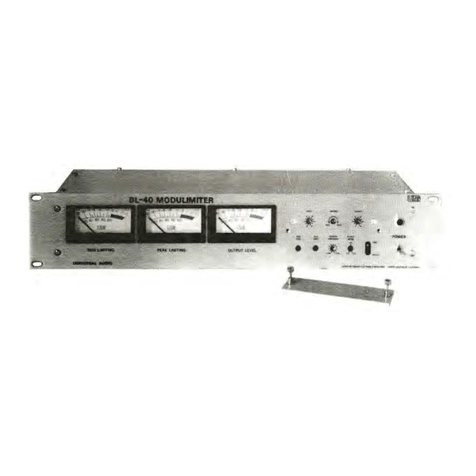
Universal Audio
Universal Audio BL-40 operating instructions
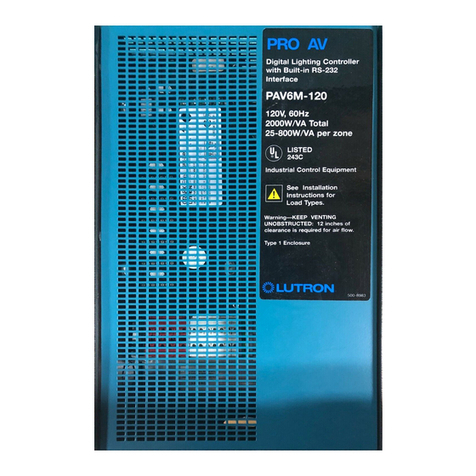
Lutron Electronics
Lutron Electronics PAV6M-120 installation guide

TimeLine
TimeLine Micro Lynx VITC Option Card installation guide

IFM
IFM AL1332 operating instructions

Marantz
Marantz DR110 user guide
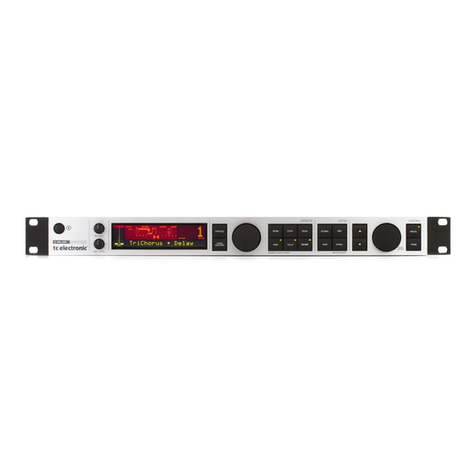
TC Electronic
TC Electronic G-MAJOR 2 user manual
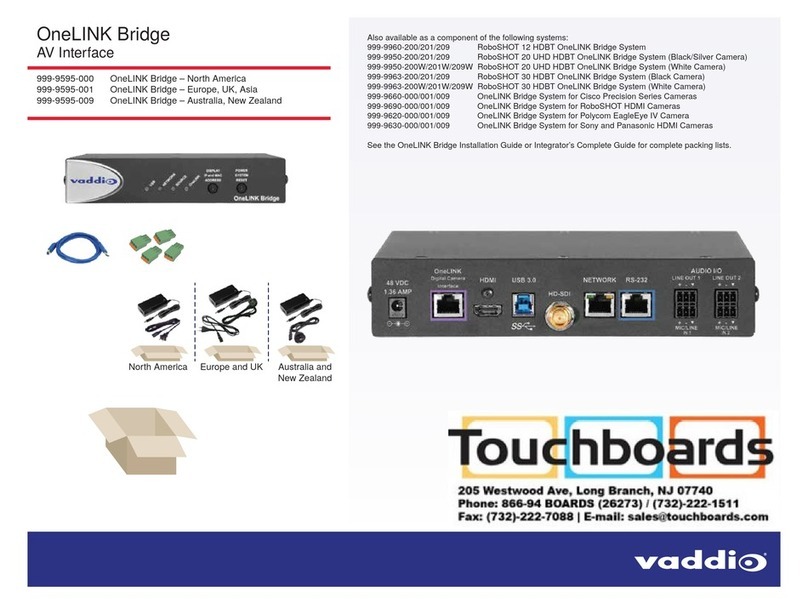
VADDIO
VADDIO OneLINK Bridge quick start guide
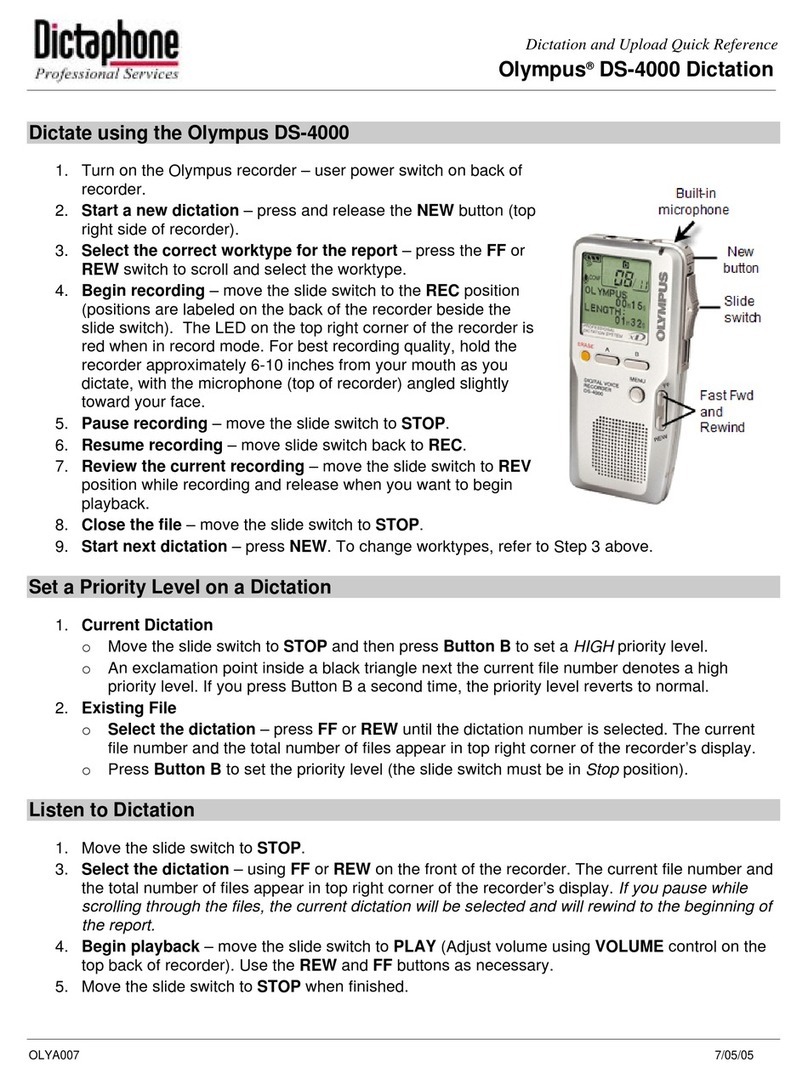
Dictaphone
Dictaphone Olympus DS-4000 quick reference
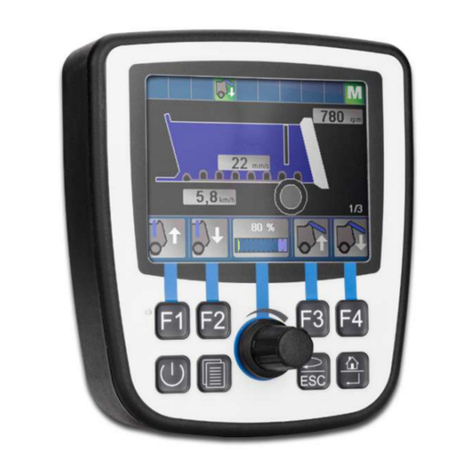
Jetter
Jetter JetViewMobile 104 user manual

DMP Electronics
DMP Electronics 862N Installation

Superscope
Superscope PSD300 owner's manual
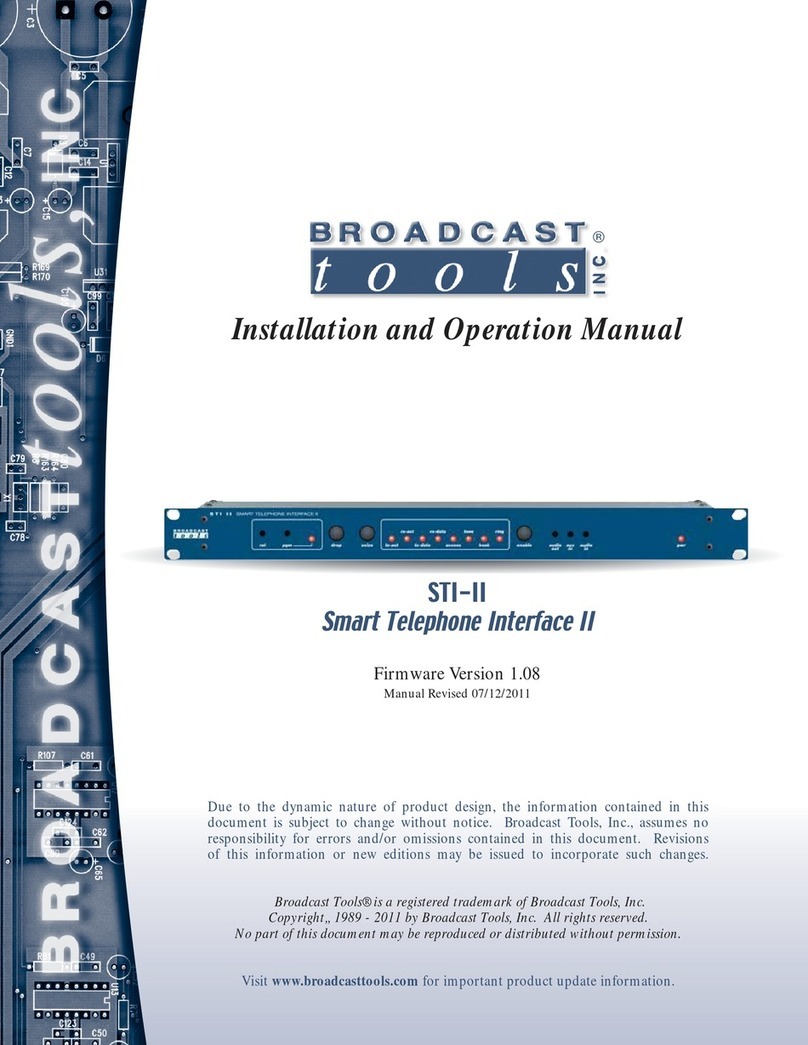
Broadcast Tools
Broadcast Tools STI-II Installation and operation manual
